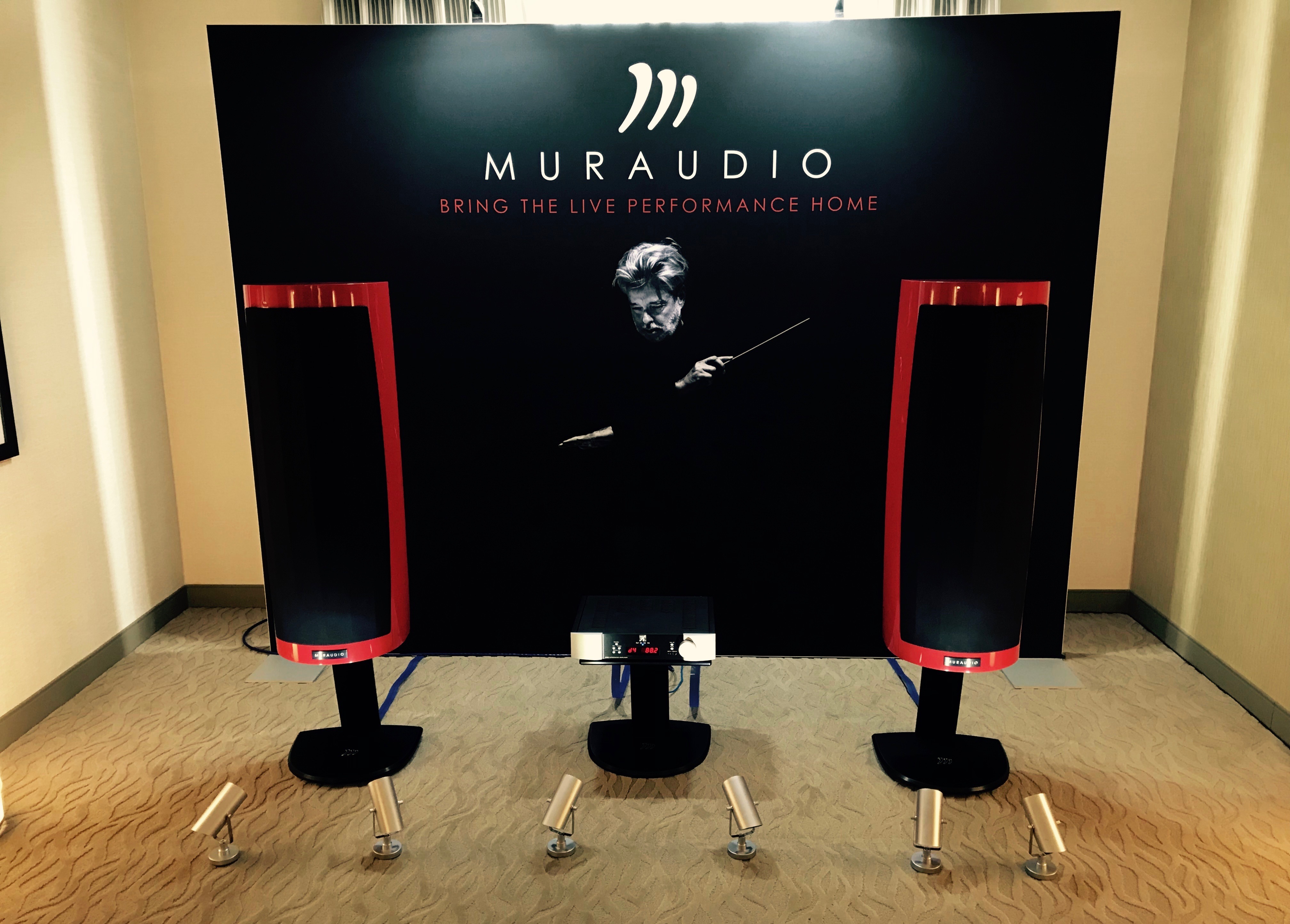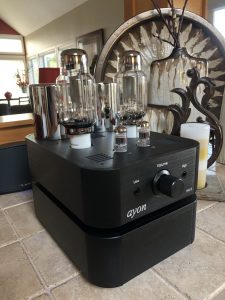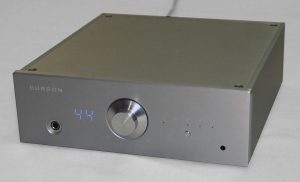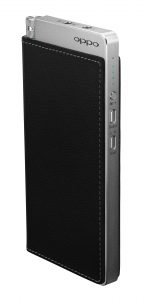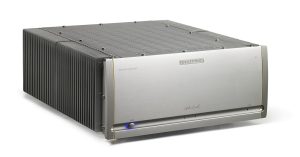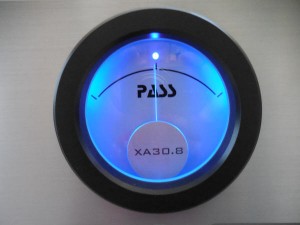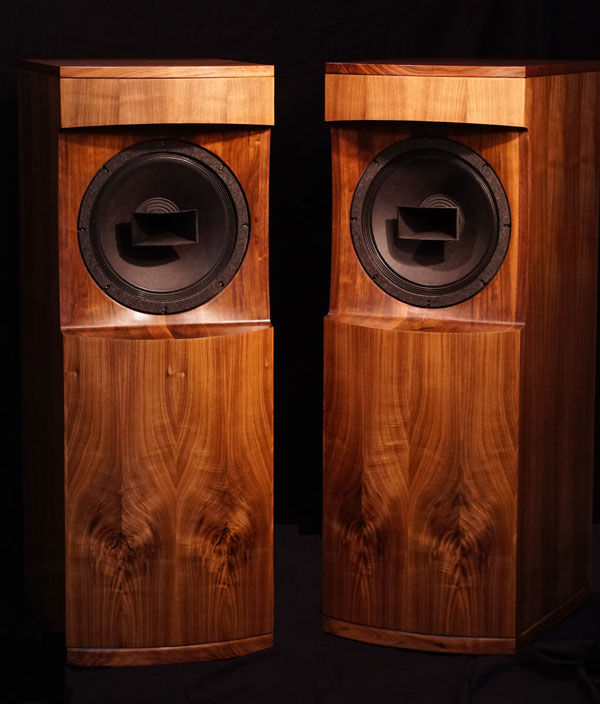
A Little Background
It's safe to say that mentioning John Tucker's eXemplar audio to an audiophile is likely to get one of three reactions. The most likely reaction is a blank stare accompanied by the questions "Who?" and "What?" There's a smaller group who hears the name and asks, "That guy with the big horns?" The third, least common, reaction tends to be wide smile and some variation on the theme of "I'm a huge fan!" That reaction is something like a secret handshake. If you're in the first two groups, you might need a little explanation why some of us are so firmly in that last group.
John Tucker gained some notoriety with Jeff Markwart in the pages of Sound Practices by documenting the steps they took to actually make Altec's great drivers sound tolerable. Then they cemented their reputation as absolute lunatics by documenting the development of the creatively named "eXemplar Horns" in "The eXemplar Project." Those of us who still obsess over our vintage Altecs tend to say his name with the kind of reverence we usually reserve for James B. Lansing.
John's work didn't stop there, though. His eXemplar audio has been quietly producing and modifying a small line of electronics for longer than I've been involved in HiFi. eXemplar has slowly built a reputation as one of the masters of the small signal tube. Their circuits are generally known best for the results of John's almost monomaniacal obsession with exterminating noise. "Almost monomaniacal," of course, because John's also been working with Winston Ma of First Impression Music, directing his talents at the studio that produces some of the best sounding digital albums on the market.
People don't just look up to John because he's so tall.
I have to confess, when David Robinson called to ask if I'd be interested in reviewing a soup-to-nuts eXemplar System, I may have been so excited to accept the offer that I agreed to do the review without even asking if I was going to get paid for it.
The Kit and the Kaboodle
The reason I jumped so very fast wasn't just hero worship. The word was that John had a new speaker in the works. Dr. Robinson was exploiting the fact that I have the kind of weakness for coaxial speakers that John Dillinger had for banks. This "eXemplar Speaker" was going to be new take on the Altec Duplex. It was going to be a labor of love. It was going to be a career high. It was going, by God, to make sure that that the duplex didn't suck this time. I couldn't resist.

A few months later, John pulled into my driveway in a low-riding minivan whose suspension angrily threatened to bottom out at any minute. After a couple of root beers, we all began the Great Unpacking. Here's what came out of the van:
- eXemplar Speakers: almost five feet tall and 230 pounds each of 100dB sensitive duplex. $29,995 per pair
- eXemplar T105: An Oppo 105 modified within an inch of its life. $5049
- eXception Integrated: A hybrid integrated amplifier kicking out 50 watts per channel. $5495
- eXception Interconnects: $350
- eXception Power Cords: $250
- eXception Speaker Cables: $395
- eXemplar E-Loops
- A crate of Stillpoints to go under everything
Then there was a quick setup, a little bit of a listen, a little dialing in, and a little more listening before, less than an hour after showing up, John was riding away in a minivan whose suspension seemed downright happy.
Meanwhile, I was left staring at the motherlode, and wondering how I was ever going to manage to review it. I eventually decided on a simple, three point strategy: Take each component in turn. Treat them individually before reviewing the system. Use as many words as possible.
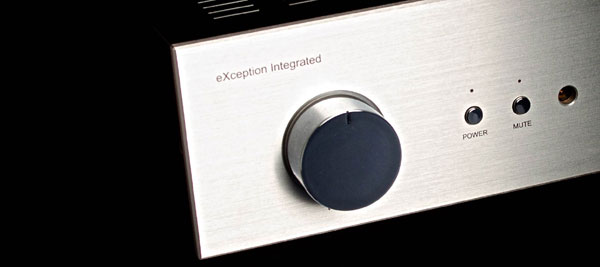
The eXception Integrated
We'll start with the amplifier. John made a valiant effort to be modest when he described it to me the first time. He said something like, "It's just a simple integrated amplifier." That misplaced modesty didn't last long. As he put it:
"Our eXception Integrated is a unique hybrid design that combines the best of tube and solid state technologies. The preamp section is a tube based design that utilizes our shunt regulators to feed the tubes. They are further controlled by our Perfect Bias Circuit which eliminates the shortcomings of most tube based designs, allowing the tubes to operate as close as possible to theoretically perfect. We then drive a solid state output section with an extremely robust power supply which provides for excellent drive and control. The combination provides an unparalleled sonic presentation."
In simple caveman terms, this little mother is heavy. Peeking through the vents shows that a full half of the chassis has been swallowed by the transformers for that "extremely robust power supply." A master power switch on the back keeps the solid state parts of the circuit on and warmed up. A front panel power switch ignites the 6n6p tubes in the front end, turns the volume all the way down, and switches the front end into the circuit two minutes later. My experience tells me that it takes just under ten more minutes to reach its peak performance.
The back panel is an ideal of clarity. Everything is labeled with big, white, easy-to-read print. Plain-looking binding posts are sized properly for a hex wrench, letting even the fumble-fingered get a secure connection with spaded cables. The firmware-controlled front panel is friendly and intuitive, with a big volume knob, a mute switch, and a selector for each of the six, numbered inputs. Since John Chapman's Bent Audio collaborated on the front panel's design, Bent Audio's finest OEM remote echoes the front panel controls perfectly. There's a notable lack of useless greebles or tacky bling anywhere.
This is, in short, the kind of amp that you can set up in the dark and use with your eyes closed. In a way, it's exactly what John described. It is "a simple integrated amplifier." That's also where John's initial modesty turns into an absolute lie. Calling this "just a simple" anything is false advertising.
I hooked this thing up to five pairs of speakers. I fed it signals from four different DACs. I watched movies through it. I fronted it with an analog rig whose price dwarfs the price of the amp. I switched it in and out of the system. I compared it directly to Manley Snappers. I compared it directly to some monster Pass amps. I swapped in a Unison Triode 25 for back to back listening. I compared it to a transformer volume control, a Pass preamp and a custom built K&K Audio preamp. After two solid weeks of listening, I thought I finally had a handle on it.
The eXception does this thing, you see, where it just gets out of the way. You start noticing it with Max Roach's cymbal work. It floats right where it's supposed to float. It's not that the image is stable so much as the room seems stabilized around it. Then there's a quality of speed that can only be described as utterly natural. I started thinking that about the other electronics. While they may have been slightly better overall, you'd have a very hard time selling them to someone who owned this amp.
That opinion continued to solidify as I listened more with the Tannoy Glenairs. Tannerds know just how hard it is to find a decent amplifier for our speakers. Sure, they're 95db sensitive. Sure, they claim to have a friendly load. It's a bunch of bull. Without the right amp, they lack dynamics, they have no bass, and their mids screech out of a honking horn. With the right amp, they offer extreme precision, dynamic tactility, and exceptional tone. With the eXception in place, the Tannoy Glenairs sounded... well... very much like Tannoy Glenairs are supposed to sound—clean. Neutral. Unforced. Kinda boring most of the time. Lotsa fun when cranked.
Ry Cooder's Boomer's Story provided a pretty good example of the ups and downs. Randy Newman's plinking piano on "Rally Round the Flag" was presented with the right simplicity, with neither the metallic edge that can seep in on some solid state amps nor the over-prominence that haunts too many tubed designs. The eXception was no better or worse than the stuff from Manley or Pass. The drums on "Coming in on a Wing and a Prayer," are a bit of a torture test. As they jump back and forth from the right to the left channel, you're looking for clarity and quick impulse response, but you also want to hear the tone of the skin in the air. Here, the Pass gear showed its clear superiority on tonal color while the Manley gear strutted its stuff on speed and staging. It's worth noting that the eXception was clearly superior to the Manleys on tone and clearly superior to the Pass on speed.
Clearly, obviously superior in both cases. This is not a small achievement.
Moving on to the Clash, whose music I can usually count on to be wholly unlistenable through too many tubed circuits, showed the eXception as being more than up to the task. Take the trivial "White Riot." I've bought some preamps and integrateds over the years—pour a beer into me sometime, and I'll tell you which they were—that... well... they keeled over. Instead of a bouncy romp, you got a wall of noise. No worries here. The eXception turned out to have the soul of a juvenile delinquent.
The differences between the amps were, for the most part, a matter of flavor. I'd characterize the eXception as being just a bit cool in its tone and just a bit cerebral in its presentation. The more expensive amps were more expressive and involving, but the eXception made up for it by being almost surgically precise and a great deal cheaper.
Now let me list my long litany of complaints. I have two.
The first complaint comes down to transparency and resolution. The more expensive linestage and amplifier combinations pulled a little more low level detail out of some recordings. Count Basie and the Kansas City 7, for instance, is full of low level muttering, mumbling, and humming. While the eXception makes you perfectly aware of that, it loses some of the tenor of those voices. You wind up hearing more intermittent glimpses of the goings on than hearing what is, in effect, a running commentary. In absolute terms, the eXception falls short of what's possible.
The second complaint is that the eXception doesn't fall anywhere near as short of what's possible as a $5500 integrated amp should. More than $10,000 of my own reference electronics barely did a better job of extracting that detail. I've had to work very hard to convince myself that the difference is, in fact, worth the price and the aggravation of dealing with a dozen more tubes. I spent a good month wondering if I would have bought any of that gear had I heard the eXception first.
John Tucker's "simple integrated amplifier" is a monster. It is—in my opinion, and by a large margin—the most impressive thing to come out of his van.
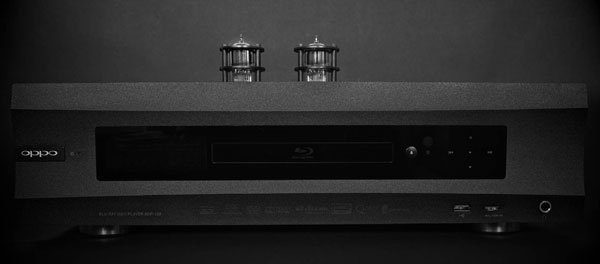
The eXemplar T105
Let me start by saying that I'm not a big fan of Sabre DACs. They're finicky. Implementing those chips well requires the kind of obsessive attention to detail that most designers don't lavish on a packaged solution. I've heard a number of them, and I've never heard one that I'd be willing to live with. In general, I find them fatiguing, tonally bleached, and dynamically boring.
I'm not all that big a fan of the Oppo products I've heard, either. They somehow always manage to sound both aggressive and muffled at the same time. It's like listening to an amphetamine loaded weasel chew through an army blanket. Sure, they're loaded with features, but they always give me that unpleasant, bullet-point-engineering vibe. Worse yet, they always get so very close to being excellent. I've even heard a few of the available mods. They keep tempting me, they keep disappointing me, and I keep deciding that I'd rather listen to Redbook though a cheap Teradak than anything at all through an Oppo.
I tell you this only to illustrate just how little I was looking forward to listening to an Oppo 105 under any circumstances. John promised good things, though, so I was willing to give it a go. Besides, it was a package deal, all or nothing, and I wanted to hear those speakers.
John Tucker may actually be a wizard. I mean an actual wizard. With robes and a wand and a pointy hat and tower and, probably, a pet dragon. While it was here, and under the right circumstances, his Oppo T105 was the equal of any source in the house. It was the best Sabre implementation I've heard—without exception!—and the only one I'd be willing to live with. It was, frankly, among the very best DACs I've ever heard. That said, I have no idea why John even bothered with this thing.
In case you're wondering, this bit is not going to be entirely positive.
The T105 shows up as two pieces, a shoebox-sized power supply and an Oppo 105 with tubes sticking out of the top. Let's let John describe his modifications:
"The eXemplar modified Oppo 105s are the results of over a decade of digital audio modifications and development. Over the years we have developed a unique combination of technologies to provide the best possible digital audio reproduction. We start by completely removing the entire analogue section after the ESS 9018 DAC chip. We replace it with our own tubed output section with an external outboard linear supply. We remove the stock regulators for the 9018 and replace it with our own very high performance low voltage shunt regulators. The signal is taken directly off the outputs of the 9018 and then wired directly to the grids of the fully shunt regulated and actively loaded tube stages. The output from the tubes is routed through DC blocking caps that we have found to be some of the best sounding available. The design of the T105s also incorporates unique EMI/RFI filtering for both power and signal carriers."
All of this works transparently. It's no harder to use than any normal Oppo, it's even quieter than a normal Oppo, and its shoebox takes up minimal rack space. Heck, the power supply for my turntable is wider.
More importantly: all of this just works. When it's at its best, it's everything you could hope for from a modern DAC. I tested it with DVDs and Blu-Rays, with SACDs and compact dics. I fed it s/pdif, toslink, and a steady diet of UPnP files. John left a 3tb drive full of music plugged in to to the back. I used it as a USB DAC. My wife and I even used it to binge-watch the first season of Helix on Netflix. We even, God help us, YouTubed on the thing.
Which starts to explain why John bothered with it. The Oppo 105 is, in theory, a complete solution. It can play nearly anything. The problems start showing up when you notice that it can't play everything equally. Or well. Or regularly.
During setup, we needed a CD to test that everything worked. The first disc to hand was everyone's favorite album, Rum, Sodomy & The Lash. The sound was immediately impressive, everyone smiled, and then we promptly left that disc in the drive.
Later that evening, using the Oppo as a USB DAC, I played the same album. It sounded like grotty hell. It was a despicable performance, inferior to the headphone output of my MacBook Air. "The Sick Bed of Cúchulainn" was absolutely punishing. It was rhythmically unstable, viciously fatiguing, and completely lacking in any sense of soundstage.
What the heck was going on here?
I hit "play" on the CD. Now the bodhran had resonance. Now the soundstage was stable. Now the sound was... well... far better than the Pogues deserve, honestly.
Huh.
That led to several nights experimenting with the plethora various inputs until I could finally categorize them and rank them. From the top:
1. PCM over s/pdif up to 24/96 is glorious. The s/pdif input is good enough to stand up to any DAC I've heard at any price, but it won't go higher than 24/96.
2. SACD is very nearly as glorious, but lacks the total rhythmic stability that the s/pdif input provides.
3. A CD in the drive is as close to perfect as a CD is likely to get. Redbook from a CD was nearly indistinguishable from Redbook over s/pdif input.
4. DVDs provided excellent sound, but not at the same quality. It was, however, good enough that watching Neil Young's solo Greendale performance in Dublin was a high point of the entire undertaking.
5. Toslink and the HDMI pass-through are actually excellent. My AppleTV fed it movie after movie without a hitch.
6. A USB drive provided sound that was almost as good as the other inputs while offering full DSD compatibility.
7. UPnP showed a severe enough drop in quality that using my library over the network was contraindicated even for background music. I listened to quite a bit of it anyway in order to familiarize myself with the quirks of the various interfaces.
8. Blu-ray was unpredictable, ranging from excellent to poor. But I watched all six Star Wars movies, and the original two were even better than I remembered.
9. The USB DAC functionality was aggressively unpleasant and best described using profanity. I don't know how this even got shipped. It's more insulting than it is disappointing.
But enough of that for now. Let's talk about the good things, the s/pdif input and the disc spinning. These are extraordinary. While some rarified ladder DACs can manage to present slightly more vivid tonal colors and slightly more exuberant dynamic bounce, very few can manage to extract this much detail or present this enveloping a sense of space.
We can revisit Boomer's Story for examples. "Coming in on a Wing and a Prayer" was easily the best I've heard from this old CD. I've long felt that the vinyl version was unbeatable, but the eXemplar T105, either spinning the disc or eating s/pdif from my music server, more than matched my analog front end in every way. Space, tone, solidity, and realism were all there. The drum had the hollowness and resonance that so many DACs—including my K&K Rakk Mk2—fail to convey. Comparing this performance to that of the Oppo HA-1 on my shelf was... well... let's not bother. There was no comparison. The eXemplar T105 was right. The HA-1, which has weaknesses with Redbook, was insufficient.
I fed track after PCM track to the Oppo through s/pdif. Warren Zevon's haunting "Don't Let Us Get Sick" was terrifyingly intimate. Duke Ellington's "Afro Bossa" was shockingly bombastic. Erykah Badu's "Rimshot" showed that there were no depths that the T105 was unwilling to plumb. Barring matters of taste, and barring the need for more than 24/96, the eXemplar T105 needs to be considered as a top-shelf DAC. It is simply unbelievably good.
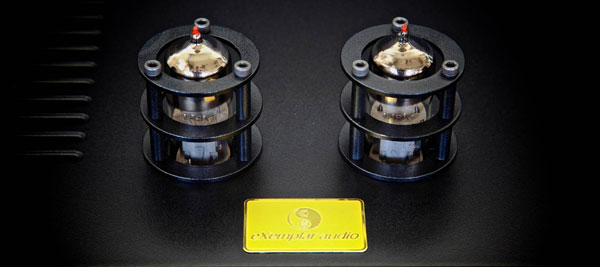
The external hard drive, sadly, proved to be wholly inferior. By comparison to the s/pdif, the Badu was unremarkable, the Zevon was at a remove, the Ellington was restrained. In absolute terms, it wasn't actually all that bad. It came very near to equalling my Rakk fed with PCM, and it had the advantage of allowing me to play DSD files (such as John's copy of Getz & Gilberto) which almost completely closed the performance gap between the two.
Still, a PCM copy of Getz & Gilberto sounded better through the S/PDIF input of the Oppo than DSD did from the Oppo's hard drive. Once I upped the resolution to 24/192, the Rakk walked quickly away from the hard-drive fed Oppo, even with the DSD advantage. UPnP mounting was again a step down, being comparable in tone and resolution to using the USB input of my MHDT Havana. It was darned convenient, though.
Worse than any decrease is sound quality, though, was the annoyance of using those inputs. Oppo's iPad app is a ugly, crash-prone disaster with sloppy interface inconsistencies and no support for playlists. Plugging the box into a TV and using its on-screen interface is more reliable and faster—until the Oppo locks hard and needs to be power cycled. I don't know about you, but if I have to reboot my DAC as though it were some spyware infested copy of Windows 98, I'm going to get just a little bit ticked off. I had to reboot it every couple of hours if I was trolling around the hard drive, and even more frequently if I was using a network share. I passed "ticked off" a long time ago. I would have hit this thing a dozen times with an axe if it hadn't been a loaner.
So what we have here is probably the best CD player I've heard, among the best SACD players I've heard, just about the best 24/96 DAC I've heard, and an exceptionally competent player of netflix, dvds, and blu-rays—all for about five grand. In that context, it has to be seen as a good deal. You also get a mediocre network player, a half-assed hard drive browser, and a completely offensive USB DAC thrown in for free.
Still... eXemplar has achieved something I never thought I'd hear: a Sabre DAC that I absolutely love. If you're looking for a disc spinner or a 24/96 DAC for your s/pdif source, this is probably your huckleberry. It's utterly fantastic in those specific roles, and, you'll probably never want more if you just limit yourself to those features. If you venture into the shinier bits of the feature set, though... well... Keep that axe handy.
If you're just looking for a good USB DAC or looking to avoid half-baked features that will drive you into a homicidal rage, do yourself a favor and pass on this one. Just see if John is building his own DAC yet. Save yourself the aggravation.
Cables, Cables, Cables
When I started in this gig, I never thought I'd be writing about cables. I sure never thought I'd be writing about cables for the same webzine that got the Amazing Randi going on his tear. I'm not entirely sure I'm up to the task, so we'll take it quickly.
John offers a bit of salesspeak to get us started:
"All our new eXception cables utilize our proprietary EMI/RFI control technology in addition to full shielding."
Let's notice the excessive performance claims, shall we? While folks do love to mock audiophiles, shielded cables with RFI filtering are hardly Voodoo Exotica these days, and, honestly, there are audiophile RCA plugs that cost more than these interconnects. Given that I plugged and unplugged every cable repeatedly over the course of a month, that all of the cables were still working and gripping at the end of the month, and that not a single connector came off in my hand while I was plugging something into the wall (and thanks for that memory, Radio Shack), I'd say they'd be worth a premium over disposable generics even if they sounded terrible.
Fortunately, they actually sound pretty good.
The eXception interconnects seemed sturdy and well enough built. Performance equaled my DH Labs cables and my low-end JENA Labs cables. My primary electronics, however, all run with balanced connections. Switching back from the eXemplar (or any) RCA cables to XLRs dropped the system's noise floor noticeably. Now, those of you who don't live in the middle of a noise triangle filled with police departments, fire departments, AM radio stations, grocery store refrigerators, and the city shop's arc welder may not find a use for balanced connections. I envy you. Still, the fact that the performance matched the other single-ended, audiophile-approved interconnects gave me some confidence that I wasn't going to leave too much performance on the floor when I moved over to the all-RCA eXemplar system. Three cheers for shielded cables!
The eXception speaker cables were similarly sturdy—by which I mean that I'd happily use them to tow a jeep out of a mud pit. The spades are enormous, and seemingly impossible to bend accidentally. The differences in my system were mostly minor compared directly to my usual DH Labs Q-10 cables, but the eXemplar goodies defined the bass a little better and removed a nasty treble sheen that I'd never noticed in my usual loom. I don't mean that the treble was cut off, mind. If anything, it seemed to be more extended. The biggest effects of this were improved soundstage depth and an ability to relax into the music more quickly. Basically, I could go from sitting on the couch to being totally engrossed in the music in about two minutes. It usually takes me about twice that long. On the other hand, the DH Labs Q-10 had a slightly more vivid vocal range with my Tannoys. You could flip a coin on this one. Add in the fact that the eXemplar cables are fifty bucks cheaper, and I'd call ‘em winners. Their only real drawback is that they're ugly. If you're looking for jewelry, look elsewhere.
John left three eXception Power Cords here. One was, specifically, a "high current" power cord to be used with amplifiers, while the other two were meant for sources. This is where we reach the limits of my competence. I'm nearly indifferent to power cords. For comparison, I had plenty of generic power cords of unknown sourcing, mostly scavenged from various computers or included in various boxes over the last umpteen years. I can say that the low current power cords did seem to lower the noise floor on my Plinius phono preamp, but did not seem to have any effect on my K&K linestage. The high current cord had no apparent effect on a Unison Triode 25 at idle, but dramatically increased transient definition when music was playing. I even listened to the eXemplar electronics for a few hours with some generic power cords. They worked well enough, but their usual precision suffered somewhat, and the experience did induce listener fatigue earlier. The eXemplar T105, in particular, benefited from the extra-cost cables. I suspect that the built in RFI filtering may have kept a little of that neighborhood arc welder noise out of the circuit.
This is all well and good so far. Tough cables, well built, shielded, a bit of RFI filtering where it counts, and you can't break ‘em when you try. Even sane people are probably saying, "Yeah, well, that's probably worth some money."
Don't get comfortable. Now we're going to go off into voodoo territory. Now we're going to talk about E-Loops.
You have no idea how much I would like to avoid this particular topic. To his credit, John looked uncomfortable with the subject when he was dropping everything off. Allow me to represent our first conversation here:
"What are those?"
"E-Loops."
"What do they do?"
"I really don't have any idea."
"What are they supposed to do?"
"I don't want to poison you. Try ‘em out and tell me if you hear anything."
"This is voodoo isn't it?"
"You tell me."
E-Loops are, in basic terms, pigtails of wire that you let hang out of an unused bit of whatever. John left one to plug into an RCA socket, and two to leave hanging out of the negative banana jacks on his amp. I swapped them in and out a few times to see if they did—how do I put this nicely?—anything at all.
They didn't at first. There were no discernible differences. They were obviously voodoo, and I was happy with the world. The problem is that they eventually did do something, and my failure to understand why continues to drive me absolutely nuts.
Before we go further: my wife and I had a deal. We might, or we might not, swap the E-Loops in or out whenever the other person left the house. If we took them out, we hid them. We weren't allowed to ask the other one if we'd done anything. I'm a terrible liar who smiles like a kid with a stolen cookie when I'm trying to run a con, so it's important to understand that we didn't ask so I couldn't give away the game. Neither of us actually cares enough to go looking behind the rack to see if a bit of wire is hanging off the back of an amp, so this was as close to a blind test as we could manage. At least one of us would have no idea if the E-Loops were in or out of the system at any given point.
And, it's true, neither one of us could ever tell if they were in or out within the first thirty of forty minutes of listening. After that, even if we were just using the stereo for background music, we could always tell.
Here's what they do when they're plugged in: a whole lot of nothing.
Here's what happens when they're not plugged in: eventually, the system gets a bit of a haze around it. It sounds a bit like playing a record in the dry, wintertime static. It's not as severe, of course. It's barely even noticeable, really. But it is an effect. After the eXemplar goodies were on for a while, they'd sound fine. After they were on for a while with the E-Loops plugged in, they'd sound great. It's not terribly subtle once you figure out what you're listening for.
I had to ask John for details. He pointed me to his website, where the E-Loops are listed under "Accessories."
"E-Loops clean up the ground plane and enhance signal flow. This results in increased detail, resolution, and musicality while lowering the noise floor, providing an overall more realistic presentation."
Okay. He's described the effect accurately, at least.
We decided to try these on other components. The K&K linestage showed no change. Neither did the Pass XP-30. A Parasound P-3, on the other hand, was even more affected than the eXemplar amp. Neither the Manley Snappers nor the Pass XA100.8 showed any changes with the E-Loops, but the Unison Triode 25 reacted the same way that the eXemplar amp did. Your mileage, in other words, can be expected to vary.
I never even asked what these things cost. I don't want to know. What I do know is that they're addressing some kind of gremlin that crops up in more than one system. Since eXemplar offers a money back guarantee on these things, you might want to give this voodoo a try.
But don't tell John I sent you. I'd be too embarrassed to admit it.
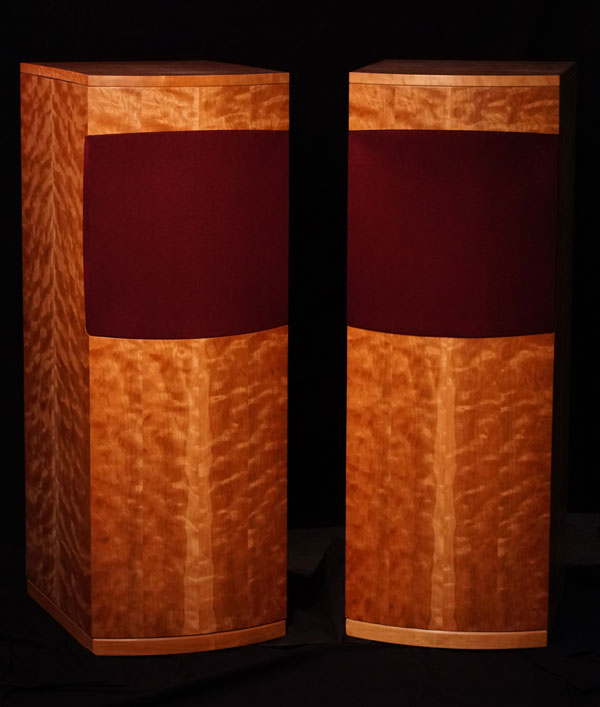
The eXemplar Speaker
The shining star! The holy grail! A duplex that doesn't suck basketballs through a straw! In the back of my mind was one single thought: "It costs thirty grand. It had better do a damn sight better than ‘not suck.'"
No worries.
Let's start down in OKC, where Bill Hanuschak, an Altec employee, bought the Altec tooling when the last vestiges of All Technical Services was swept away by encroaching modernism, brand necrophilia, and a decade and half of piss poor quality control. Bill wasn't content to let the Altec flame go out. Altec may have made some of the worst speakers the world has ever seen, but, by God, they made drivers. They made big, beefy drivers that filled movie theaters. They made tight, detailed drivers that produced the music for two generations. And those were the same drivers. So Bill first geared up as a service depot, and then Bill went into production as Great Plains Audio. Over time, as every artist, craftsman, or engineer worth his salt does, Bill made tweaks.
A few years ago, his tweak involved a new horn for the venerable 604 Duplex. This version, called the "604-8H-III" sported a new flare and a sensitivity that was just a hair over 100db per watt. You probably remember when it was released, because the entire Altec DIY community cried "Holy Mother of God!" at the top of their lungs.
Please understand something important: Bill is a nice guy, but he's genuinely the worst salesman I have ever encountered. He won't update his website. He rarely—if ever—admits that he even has an email account. I once called him to ask about his alnico duplexes, and, when he picked up the phone on my eighth try, he advised me to go away and save my money.
That guy, the guy who won't sell you the time of day when you offer him a few grand, sounds like a kid who just found out he's getting a snow day when he talks about the 604-8H-III. "It's the best duplex ever," he says.
That's where you start. Then you add John Tucker and his obsession with sonic purity. Then you add Jeff Markwart, whose phase-coherent crossovers define what's possible with a good duplex. And then you add the secret ingredient, David Florio. Let's turn it over to John for the introduction:
"The eXemplar speakers are built by David Florio of Audio Resources. David began building speaker enclosures in 1971. He was instrumental in the design of the first sound system used by then fledgling California based sound company Ling Audio, in the late seventies. He worked as a department head during the early to mid-seventies at Electro-String Instrument Corporation, best known as the manufacturing arm of Rickenbacker guitars, at QSC Audio products, first as an electro-mechanical assembler, then a second employment years later in the engineering department providing production floor assembly drawings, as a line lead on the amplifier line at the ALTEC-Lansing Anaheim plant, assembled raw frame speakers at Emilar. To say that he is well versed in all things audio is an understatement. He began Audio Resources in 1995 to provide various services to the music community in Seattle, which included vintage amplifier cabinet restorations, repairs, custom speaker enclosures, sound reinforcement enclosures, flight cases for musicians and back line rental stores. Construction of custom audio-related furniture and producers desks for churches and recording studios. OEM supplier to Soldano Amplifiers, THD Electronics, CM Labs MotorMix, Condor Electronics Maxi-Matcher vacuum tube tester, and Speedster Amplifiers."
Dave not only builds these things in his shop, but he's responsible for the basic look and loading of the eXemplar Speaker cabinet. On first glance, you might think of this as a tarted-up Stonhenge. After all, it's a ported box with just about nine cubic feet of air inside it. It also sports a carved, wooden baffle (walnut on the pair that visited me), matched veneers all around, new loading, new damping, flush mount grills that match the cabinets' curves, and a hand-rubbed finish that appears to be about forty three feet deep.
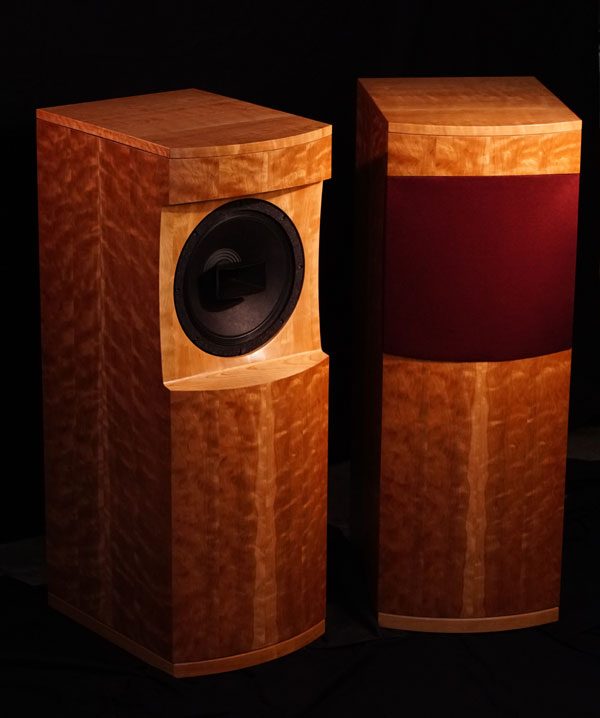
I'm just guesstimating that last part. It could be fifty feet deep for all I know. I don't like to pry. It is, either way, gorgeous.
The speakers are also 54" tall without footers, 19.5" wide, 26" deep, and about 230 pounds each. Nobody will mistake them for a compact speaker. I'll offer that my wife suggested that they were among the two or three most beautiful speakers she'd ever seen. My wife, however, is the kind of person who dismisses Harbeth Monitor 40s as—and this is a direct quote—"small speakers for tiny wimps."
Ahem. Moving on.
Once you get done with ogling the craftsmanship—if you get done with ogling the craftsmanship—you'll have to mount the footers. Unlike the spikes or rubber feet that adorn most of our speakers, the eXemplar Speakers sport a Stillpoints Ultra 5 at each corner. Normally seven hundred smackers each, all eight feet are included with the the price of the speaker.
I'd recommend having at least one friend around to help steady the speaker during the mounting process. Actually, you'll probably want a couple of backup friends around for additional first aid. People tend to choke on their own tongues when you tell them that each foot of your speaker costs more than they've spent on records in the last ten years. Ignore those people. At this price point, the performance gains are entirely worth the outlay.
It's not that the bass tightens up, or that there's more bass, or bassityy bass bass bass bassgasm, or whatever the common knowledge says about the proper floor interface. The difference between a speaker wearing Stillpoints and an unshod speaker sitting on my carpeted floor had very little to do with bass at all. The effects were more obvious the higher up in the frequency range the speaker climbed. The vocal range took on more clarity, the higher treble ranges lost the last traces of spittiness, and the the always wonderful, duplex soundstage solidified in a way that will simply remove the word "diffuse" from your vocabulary.
After you're done with that, you can use a socket wrench to tighten down your (mandatory) biwired cables in the (spade only) binding posts before you start sliding the eXemplar behemoths into their final resting spot.
Happily, that process is relatively easy. The speakers worked well either close to the rear wall or far away from it. We tried them at distances ranging between one and five feet from the back panel, and we settled on something just over two feet as the best compromise between sound quality and ergonomics. Keep them away from the sidewalls, toe them in so the horns point in the general direction of your head, and get listening. Fine adjustments matter, of course, but they don't matter enough to slow down your setup process.
The back panel also features two knobs to adjust the crossover behavior for your room. If you check Jeff Markwart's website, you'll find the circuit diagram of his crossover for GPA's last attempt at a ferrite duplex. The new crossover works in the same way, and the pictured L-pads do the same job. The bottom knob adjusts the MF EQ, and the top one adjusts the HF EQ. No matter how many times we tried to set these by ear, no matter how many times we tried to set it by trusting a microphone, the knobs always turned to within a hair of where John had set them when he dropped of the speakers. How far you turn these knobs will be so firmly dictated by your room and your ancillary equipment that you have very little chance of screwing things up.
Now you can finally sit down to listen, and this is when, if you're like me, you discover the major flaw in these speakers.
John Tucker is quite obscenely tall, looming well over six feet. I, on the other hand, am one of those folks who needs a step ladder to change lightbulbs. The tweeter's horn was just a quarter inch too high for me to sit in my usual spot. I needed a either a booster seat or a phone book. My less humiliating solution was to push my couch back an extra foot, putting me almost six entire feet from the front of the speakers. In fairness, John recommends that listeners try to sit at least ten feet away. He's right. That distance sounds great. It doesn't, however, sound better.
Long suffering fans of Altec's duplexes will cock their heads at that last sentence. A few of them are probably thinking, "sit close to a 604? IS HE MAD?" Sitting within, say, five hundred feet of a 604 with a stock Altec crossover isn't likely to be pleasant. Listening to a pair in the near field is just masochistic self-abuse on the same scale as jamming a cattle prod into your ear. Nobody in their right mind ever sat closer that fifteen feet to a pair, and you can count on the fact that anyone who worked with duplexes in the nearfield is probably half deaf from the long term scarring on their eardrums. As a nearfield monitor, the 604 liked a big personal bubble. It was one of its defining qualities. It's fair to say that the eXemplar Speaker does a lot to ameliorate that particular flaw. In my room (in a high enough chair), I found that leaving anything between four feet and eighteen feet between me and the front plane of the speakers worked equally well.
That's your first sign that you're not going on any kind of nostalgia trip. If you're expecting the vintage experience, you're going to be deeply disappointed. These may have a retro look to them, but these giants make a thoroughly modern sound. You can tell how modern it is, because the sound quality is almost entirely dictated by the upstream electronics.
Pairing the eXemplar Speakers with my Manley Snappers gave me a sound characterized by dextrous speed. This was a system that took the Chris Duarte Group's "Shiloh," and shredded with it. With the Pass amplification, the eXemplar Speakers were subtle juggernauts, powering their way through the London Classical Players and the Schütz Choir of London's take on Die Zauberflöte with a natural ease. A pair of 8 watt Hagerman Cymbals (Why, oh why, are these out of production?) took over for a bit, doing justice to Barbara Hendricks & The Monty Alexander Trio's Tribute to Duke Ellington, with admirable clarity and plenty of bounce. The only real commonality between the pairings were the constant tactility of the big drivers—a quality that smaller radiators simply never match.
On the other hand, the lovable Unison Research Triode 25 proved to be a terrible match in any of its four operating modes, reacting with the eXemplar Speakers in a way that was far too familiar to Duplex listeners: the tweeter started giving too much output below 1.5kHz. If you've ever sat next to a 604-8k at close range, you'll know this sound. It's nothing but breakup.
Careful amp matching isn't the only thing that's required. You'll want to be careful all the way up the chain. If a component tends toward the bright, such as an Oppo HA-1 fed a steady diet of Redbook, the eXemplar Speakers quickly turn aggressive. Switch that with an MHDT Havana, and the sound turns warm and bloated. If a component sounds grainy, such as a Denon 103r when compared to Dynavector XX2, that grain will stand out as much as the Denon's meaty midrange. There's a sense in which these speakers could be called "ruthlessly revealing."
Once you've settled on the ancillary gear, though, you'll start to think of them as "transparent." They can't make a bad recording sound good, but that never seems to get in the way of listening. Listening to the worst CD transfer ever, an abysmal, 80's vintage, "Best Buy," $5.00 when new and too expensive at the price, copy of Iron Butterfly's In-A-Gadda-Da-Vida is as tolerable as it can possibly be. Even MP3s from the Cartoon Network compilation Africa Swim were entertaining party music. You will, for the most part, pay more attention to getting your gear sorted than playing any specific genre or format. If that's "ruthlessly revealing," I, for one, welcome our ruthless overlords.
There is one exception to the otherwise pathological versatility, a weakness that's simply a part of the Duplex DNA. That exception is that you probably won't want to listen to too much music with too much deep bass. The eXemplars are absurdly powerful to 60hz, sufficient and authoritative to 40Hz, and only nominally present by the 20Hz-ish range. You'll have no problem listening to Mingus (you really want to hear Mingus on these), but you're probably not going to be spinning Chris Randall's blues albums or Liquid Stranger all that often. Oliver Latry organ albums are right out. If your happiness depends on sub-harmonic bass, you'll want subwoofers that can keep up with the speed and prodigious output of which these speakers are so absurdly capable.
I should mention that eXemplar audio, by happy coincidence, produces such subwoofers.
There are a few of other flaws in absolute terms. The high treble through the coaxial horn can't quite match the smoothness of, say, a Raal ribbon or Acapella ion tweeter. It's of such a contiguous whole with the rest of the presentation, though, that the excellence of the end result would seem to outweigh that shortcoming. Outside of the sweet spot (which covered just about the entire seating area of my eight foot wide couch), treble performance above about 12kHz drops rapidly. The asymmetric horn means that the vertical dispersion is not quite the same as the horizontal, so walking around while being obscenely tall isn't recommended. The ferrite drivers in these speakers seem to miss that last bit of microdetail that Alnico drivers always manage to dig out of every recording. If that's important to you, you should probably stick to your Lowthers or your vintage drivers. Lastly, and most obviously, the eXemplar speakers also cost thirty grand, which is approximately thirty grand more cash than most of us generally have on hand. That puts something of a hard limit on how many people will get to enjoy these things.
None of that keeps the eXemplar speakers from being the most neutral, most listenable, and most consistently excellent 604 derivative I've heard. They're an analytical tool that rivals some of the spendiest and trendiest modern designs that I've encountered. If you have the spare cash and you're looking for lightning fast transparency, you should probably see about setting up an audition at your earliest convenience.
All the Soup to All the Nuts
If the speakers are neutral, and the cables are neutral, and the source sounds neutral, where does that leave us when trying to describe the full system? Stealing words from the amplifier's description, that's where.
Cool. Natural. Cerebral.
The whole system's consistent evenhandedness offered a rare combination of a wholly analytical balance with a completely relaxing, fatigue free presentation. If anything, assembling the full system made abundantly clear just how much that the amplifier's character dominated the final presentation. I walked away with the distinct impression that the system wasn't designed to fill any emotional holes so much as it was designed to fill a professional need.
As a whole, then, this was a system clearly meant for the engaged listener, a listener who listens for something rather than to something, and one who listens for hours at a stretch. Whether that something is every shifting splice in the plunderphonics masterpiece Greyfolded, the slap echo that haunts the Anonymous 4's Love's Illusion, or just for the heartbreaking tenderness of Johnny Cash's last "Aloha Oe," the eXemplar system always offered a chance to treat a listening session as some sort epic quest. In the great tradition of epic quests, of course, every listening session went on much longer than planned
If that sounds like an attractive proposition, you might want to check in on eXemplar audio. If you do, take my advice: listen to the amp first. That little sucker is a superstar. It's good enough that I'm even willing to type its proper name, the eXemplar eXception Integrated Amplifier.
But I'm only willing to do that this once.
System prices: As listed in the review.
eXemplar audio
2909 95th Drive SE
Lake Stevens, WA 98258
Sales, Bruce Jacobs, 651.315.4248
[email protected]
Factory/Show Room, John Tucker, 425.334.4733
[email protected]
www.exemplaraudio.com
Photographs courtesy of John Tucker/eXemplar Audio
Malachi Kenney is a writer and reviewer for Part-Time Audiophile. I have a high regard for Malachi's writing, and knowing of his interest in the driver in John Tucker's new high-efficiency eXemplar speaker, I invited him to do a guest stint at PF with it. He did so…the results follow.




